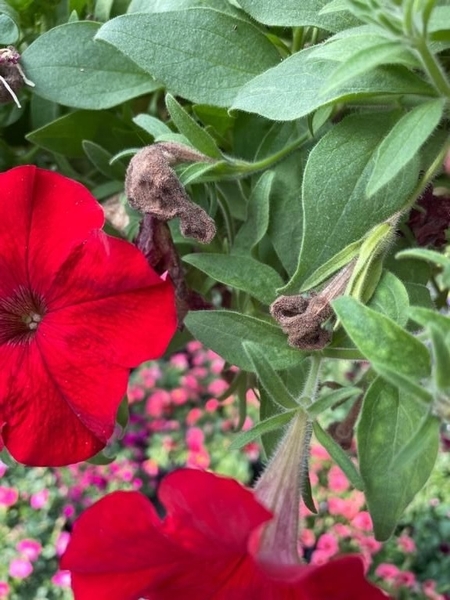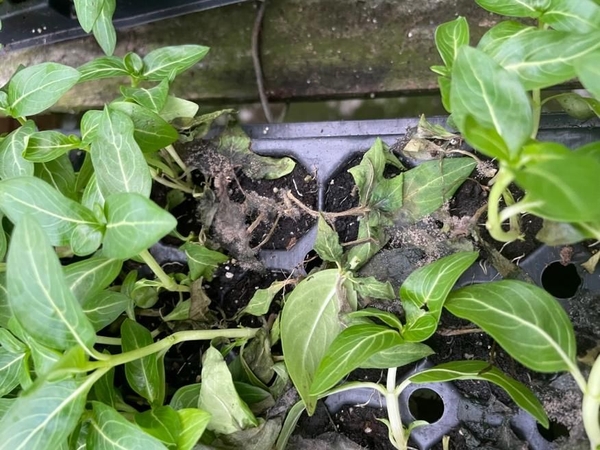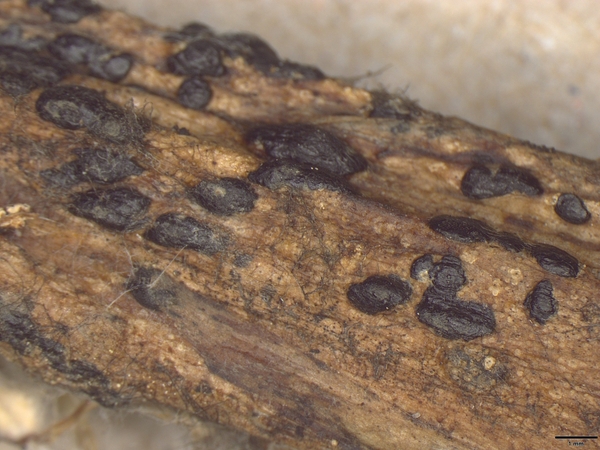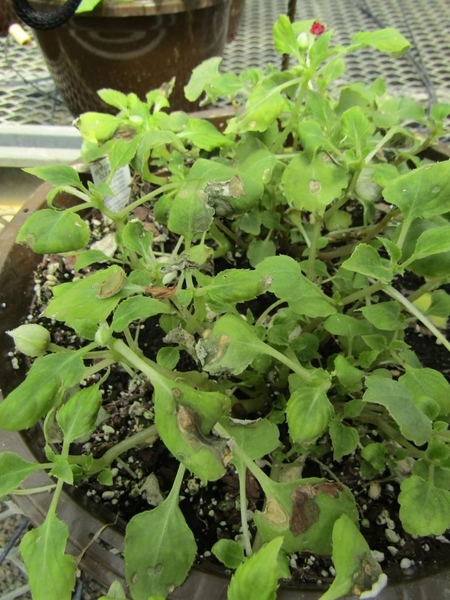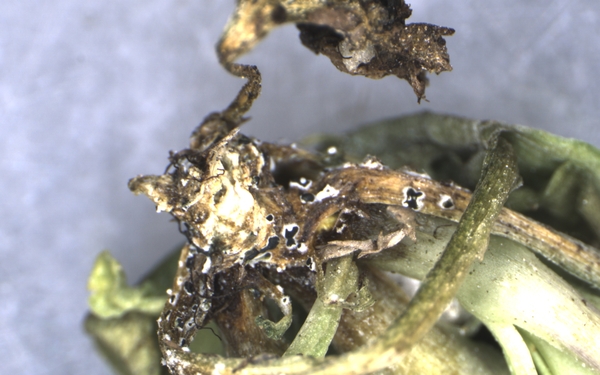Introduction
Botrytis blight, or gray mold, is a fungal disease that is widespread in the United States and globally. This fungus spreads via spores in the air and can result in economic losses if not managed early. In North Carolina, this pathogen is most threatening in the spring when temperatures are cool.
Pathogen
Botrytis blight is caused by many species of Botrytis, the most common of which is Botrytis cinerea.
Host Plants
This fungus has the capacity to affect a wide variety of ornamental plants including calibrachoa, geranium, annual vinca, poinsettia, cineraria, and many others.
Symptoms and Signs
Botrytis cinerea has the capacity to affect essentially every above ground part of the infected plant when conditions are favorable for disease development and preventative measures are not taken. Gray mold is often found on leaves in the densest part of the canopy. It may also be found sporulating on dead flowers or other senescent tissue (Figure 1 and Figure 2). This is often where Botrytis gets its start, later spreading to younger tissue in contact with the dead blossoms. Symptoms of a Botrytis infection may include lesions on stems or petioles, leaves that may appear dark-colored or gray, and—on flowers—white or light-colored flecks may appear on petals. Additional symptoms include soft rots, and irregular tan to gray lesions that form prior to sporulation on leaves and stems. Under high humidity, a gray fuzzy mold appears on the affected plant parts (Figure 3). This is the sporulation of the fungus. Botrytis also can cause damping off on newly emerging seedlings.
Overwintering structures (sclerotia) can also form on affected plant tissue (Figure 4). Sclerotia are black in color and appear flat or raised.
Look-Alike Diseases
Certain symptoms of Botrytis blight can resemble those of other conditions and diseases that affect greenhouse ornamentals, including Myrothecium leaf spot (Figure 5). Myrothecium roridum is a fungal pathogen that causes gray to brown leaf spots often with concentric rings that are initially similar to the leaf spots caused by Botrytis. However, these two pathogens can be differentiated based on signs of the pathogen: M. roridum produces tiny, globular structures (</= 2 mm diameter) with a dark black or olive green center (this is the mass of spores) surrounded by a white mat (mycelium) (Figure 6) whereas Botrytis forms dark colored spores that arise from mycelium (the vegetative thread-like structures) and appear as a “gray fuzz” (Figure 2, Figure 3, and Figure 6). On stems, symptoms of Botrytis could be confused with those caused by Rhizoctonia, Sclerotinia, or even Berkeleyomyces. In the absence of sporulation, these other diseases may be difficult to differentiate from Botrytis blight, but Botrytis can be encouraged to sporulate by placing in a humid chamber (plastic box with some moisture for humidity) kept at room temperature for 24 to 48 hours.
Disease Cycle and Epidemiology
Resident populations of B. cinerea in a greenhouse can remain dormant until conditions and suitable host material are available. It can also come in with infected plants. Sclerotia overwinter on plant debris, leading to Botrytis blight outbreaks in early spring. Optimum conditions for the growth of B. cinerea are temperatures from 60-70°F coupled with high relative humidity (>85%). When temperatures are greater than this range and/or when humidity is low, gray mold does not develop. Spores of B. cinerea germinate under optimal conditions and can gain entry through wounds and natural openings or mycelial growth from infected plant tissue. After a plant is infected, mycelia (vegetative thread-like structures that obtain nutrients) grow inside the host tissue causing lesions and tissue death. Under favorable conditions, the fungus sporulates, and these spores spread via air and water splash to infect other susceptible plants. After B. cinerea has become successfully established, it is easy for it to infect an entire production greenhouse. Botrytis cinerea cannot be eradicated because of its ablity to survive in greenhouses in the absence of host plants and because it is ubiquitous in the environment.
General Disease Management
The key to managing Botrytis blight is avoiding the conditions that are conducive to this disease: high humidity (85% or higher) and cool temperatures (60-70°F). Outside of these conditions, Botrytis blight does not develop well, if at all. In greenhouses in NC, January through April appears to be “peak season” for Botrytis blight based on samples submitted to the NC State Plant Disease and Insect Clinic. However, Botrytis blight can occur anytime of the year when conducive conditions are present (e.g. following several days of rain).
Avoid Excessive Periods of Leaf Wetness and High Humidity
Drip irrigation is recommended to avoid prolonged periods of leaf wetness and spore dispersal via water splash. If you must overhead irrigate, do so at a time when foliage will dry quickly. Botrytis blight can be managed and reduced by avoiding prolonged periods of leaf wetness and avoiding periods of high humidity longer than 3 hours per day.
Ensure Good Air Circulation
Adequate air circulation, even when humidity is high, can greatly reduce the development of gray mold. Ensure there are no “dead air” spots in the greenhouse by adjusting fan placement.
Inspect Plants Often
Scouting plants regularly helps catch and manage disease problems early.
Remove Dead Plant Tissue
Botrytis tends to gain entry into the plant through necrotic areas or dead flowers, so care should be taken to remove dead portions of the plants and dispose of them outside of the greenhouse or facility. Because dead plant tissue provides a substrate for the fungus to sporulate and survive long-term, it is important to remove dead plant tissue to prevent an outbreak during the season and in the following season.
Maintain Healthy Plants
Botrytis blight development primarily occurs on unhealthy, wounded, stressed, or inactive plants, as they are the most susceptible to infection. Maintaining vigorous plants using appropriate fertilization and irrigation practices can reduce the development of gray mold.
Host Resistance
Host resistance to Botrytis blight is uncommon because of the “generalist” nature of the pathogen and the frequent changes in cultivar demand; however, Shrestha and Hausbeck (2021) identified less susceptible varieties of geranium: ‘Horizon Coral Spice’, ‘Pinto Premium Orange’, and ‘Ivy Tornado White’. Although susceptibility of cultivars within other plant species is largely unknown, greenhouse growers may observe differences in susceptibility among varieties or plants they grow.
Preventative Fungicide Program
A rotation of fungicides can help to successfully manage Botrytis blight if the above cultural practices are employed. Fungicides alone will not effectively manage this disease. In addition, Botrytis species are known to develop resistance to multiple FRAC groups, so it is extremely important to rotate fungicides.
Disease Management for Conventional Growers
Conventional growers should incorporate the management practices listed above in addition to a fungicide spray program. Please note: Many strains of Botrytis cinerea have developed resistance to multiple fungicide modes of action listed below. It is extremely important to rotate FRAC numbers to avoid resistance in this pathogen. In general, FRAC groups with “M” are broad-spectrum and the risk of fungicide resistance to these fungicides is low. On the other hand, FRAC groups with a single number (no “M") are single-site fungicides and the risk of fungicide resistance is high. Based on a recent study by Lukasko and Hausbeck (2023), fungicide resistance is more common to FRACs 1, 2, 7, and 11. See pest alert “Fungicide resistance in Botrytis: A reminder for floriculture crop producers” from March 2024 for more details.
| Product name | Active ingredient | FRAC | Rate of Formulation |
|---|---|---|---|
| (various)
|
copper
|
M01
|
See label
|
| (various)
|
mancozeb
|
M03
|
See label
|
| (various)
|
chlorothalonil
|
M05
|
See label
|
| (various)
|
chlorothalonil + thiophanate-methyl
|
M05 + 1
|
See label
|
| Zyban WSB
|
thiophanate-methyl + mancozeb
|
1 + M03
|
24 oz/100 gal (4 bags)
|
| (various)
|
thiophanate-methyl
|
1
|
See label
|
| (various)
|
iprodione
|
2
|
See label
|
| 26/36, Dovetail
|
iprodione + thiophanate-methyl
|
2 + 1
|
33 to 84fl oz/100 gal
17 to 34fl oz/100 gal |
| Terraguard SC, Trionic
4SC |
triflumizole
|
3
|
4 to 8 fl oz/100 ga
|
| Concert II
|
propiconazole + chlorothalonil
|
3 + M05
|
69 fl oz (4.3 pt)/100 ga
|
| Astun
|
isofetamid
|
7
|
10 to 17fl oz/100 gal
|
| Broadform SC
|
fluopyram + trifloxystrobin
|
7 + 11
|
4 to 8 fl oz/100 ga
|
| Orkestra Intrinsic
|
fluxapyroxad + pyraclostrobin
|
7 + 11
|
8fl oz/100 gal
|
| Palladium WDG
|
cyprodinil + fludioxonil
|
9 + 12
|
4 to 6 oz/100 gal
|
| Compass 50WDG
|
trifloxystrobin
|
11
|
2 to 4 oz/100 gal
|
| Heritage WG
Heritage SC |
azoxystrobin
|
11
|
4 to 8 oz/100 gal
7.7 to 15.3 fl oz/100 gal |
| Disarm M
|
fluoxastrobin + myclobutanil
|
11 + 3
|
11 fl oz/100 gal
|
| Mural WG
|
azoxystrobin + benzovindiflupyr
|
11 + 7
|
4 to 7 oz/100 gal
|
| Medallion WDG, Emblem
SC, Spirato GHN |
fludioxonil
|
12
|
See label
|
| Decree 50 WDG
|
fenhexamid
|
17
|
0.75 to 1.5 lb/100 ga
|
| Affirm WDG
|
polyoxin D zinc salt
|
19
|
0.25 to 0.5 lb/100 ga
|
Disease Management for Organic Growers
The most effective way for growers to avoid Botrytis blight is to employ the cultural management practices mentioned above. Various biorational products including Serenade Opti, Serifel, Botector, Zio, and Ecoswing have been proven effective in reducing the number of blighted leaves, foliar lesions, and leaves with B. cinerea sporulation when combined with the least susceptible geranium cultivars (e.g., Pinto Premium Orange) (Lukasko and Hausbeck, 2023). PreStop and Regalia (both OMRI-listed) have shown some efficacy as reported in research reports by the IR-4 Project (Environmental Horticulture), but results were variable among experiments.
Additional Resources
The NC State Extension Plant Disease and Insect Clinic provides diagnostic services and management recommendations.
The NC State Extension Plant Pathology Portal provides information on crop disease management including pest news and alerts.
The NC Agricultural Chemicals Manual is updated annually and provides pesticides labeled for use on ornamentals.
Publication date: March 22, 2024
N.C. Cooperative Extension prohibits discrimination and harassment regardless of age, color, disability, family and marital status, gender identity, national origin, political beliefs, race, religion, sex (including pregnancy), sexual orientation and veteran status.
NC Cooperative Extension prohíbe la discriminación por raza, color, nacionalidad, edad, sexo (incluyendo el embarazo), discapacidad, religión, orientación sexual, identidad de género, información genética, afiliación política, y estatus de veteran.
Recommendations for the use of agricultural chemicals are included in this publication as a convenience to the reader. The use of brand names and any mention or listing of commercial products or services in this publication does not imply endorsement by NC State University or N.C. A&T State University nor discrimination against similar products or services not mentioned. Individuals who use agricultural chemicals are responsible for ensuring that the intended use complies with current regulations and conforms to the product label. Be sure to obtain current information about usage regulations and examine a current product label before applying any chemical. For assistance, contact your local N.C. Cooperative Extension county center.
N.C. Cooperative Extension prohibits discrimination and harassment regardless of age, color, disability, family and marital status, gender identity, national origin, political beliefs, race, religion, sex (including pregnancy), sexual orientation and veteran status.

